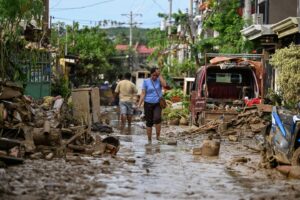The catastrophic impact of Typhoon Kalmaegi, known locally in some areas as Typhoon Tino, has unfolded across the central Philippines, leaving a wake of destruction and triggering a large-scale humanitarian emergency. Days after the powerful storm tore through vulnerable archipelagic regions, the confirmed death toll has surged dramatically, prompting urgent government action and massive search-and-rescue operations. The immediate crisis is compounded by the looming threat of a subsequent, even stronger storm, threatening further calamity across the region.
The Philippines Bears the Brunt of the Disaster
The sheer scale of Kalmaegi’s devastation became clearer on Friday as official figures confirmed the loss of at least 188 lives across the Philippines, according to reports citing government statistics. This represents a significant and sobering increase from the 114 deaths reported just 24 hours prior, highlighting the challenges in accessing and assessing the hardest-hit low-lying communities. Beyond the confirmed fatalities, the disaster has also left over 127 individuals missing, fueling fears that the final count will continue to rise as recovery teams navigate mud-strewn streets and collapsed infrastructure.
Visual documentation from the affected areas paints a grim picture: submerged vehicles, streets choked with mud and debris, and massive uprooted trees illustrate the storm’s raw power. The priority now rests squarely on the ongoing search-and-rescue efforts, with military and civilian teams racing against time to locate survivors in communities that were overwhelmed by flash flooding.
The disaster’s reach is vast, with the typhoon impacting more than 10 regions of the country. Consequently, Philippine President Ferdinand Marcos Jr. declared the situation a national “calamity.” This crucial declaration is designed to streamline the national response, offering “quicker access to some of the emergency funds” and expediting the procurement and distribution of essential aid and supplies to the affected populace, as confirmed by local media outlets.
Mass Displacement and the Strain on Resources
The humanitarian challenge is immense. The typhoon’s force has led to the displacement of over 560,000 residents. A significant portion of this population—nearly 450,000 people—sought refuge in emergency shelters, pushing the capacity of local relief systems to their limits. Authorities noted the foresight of local governments, which successfully managed to evacuate over 200,000 individuals before the storm made its initial landfall on Tuesday, undoubtedly saving countless lives despite the eventual catastrophic outcomes.
Among the areas most severely impacted is the province of Cebu, a major hub and popular tourist destination renowned for its coastal beauty. Drone footage captured the utter destruction in places like Talisay City, where homes along riverbanks were flattened and buried under thick layers of mud. Military personnel have focused their efforts on locating the missing in these highly vulnerable coastal and riverside communities, which bore the full brunt of the storm surge and unprecedented flooding.
Kalmaegi Continues its Path of Destruction in Vietnam and Beyond

After exiting the Philippines and traversing the South China Sea, Typhoon Kalmaegi made its second devastating landfall, striking the central regions of Vietnam. Vietnamese disaster prevention officials reported robust wind speeds reaching up to 82 mph as the storm came ashore. While meteorologists project a gradual weakening of the storm as it tracks in a northwesterly direction, the immediate threat of widespread flooding and damage remains severe.
The storm’s impact extended to the south, where high tide coincided dangerously with the heavy rainfall brought by the typhoon. The U.S. Embassy in Vietnam issued an official alert warning of a heightened flood risk, specifically targeting areas along the Saigon River. Local authorities in Ho Chi Minh City (HCMC) escalated warnings for the city, which is already notoriously susceptible to severe inundation, urging residents to prepare for the potentially devastating consequences of the combined rain and high water levels. Dramatic photographs captured the tempestuous scene along the Vietnamese coast, showing powerful waves violently crashing ashore, a precursor to the storm’s arrival.
Following its trek across Vietnam, the fast-moving weather system is forecast to continue its destructive trajectory towards Cambodia and Thailand, necessitating heightened regional vigilance and preparedness efforts across mainland Southeast Asia.
The Looming Shadow of Supertyphoon Fung-Wong
As rescue and recovery operations intensify in the wake of Kalmaegi, the region is bracing for an even more formidable threat: Typhoon Fung-Wong. Developing to the east of the Philippines, Fung-Wong is currently on a path of rapid intensification. Forecasters predict it will reach Category 4-equivalent Supertyphoon status by the weekend.
This ominous development threatens to inflict a fresh wave of severe weather on the northern Philippines. The storm’s trajectory suggests it will likely bring torrential, flooding rain, powerful and damaging winds, and a dangerous storm surge to the northern part of Luzon, particularly from Sunday into Monday. While the current projections indicate that the most severe impacts of Fung-Wong may narrowly miss the capital, Manila, the northern provinces remain under high alert.
The back-to-back threat of these cyclones underscores the increasing vulnerability of the Southeast Asian region to extreme weather events, which are often exacerbated by the accelerating effects of climate change. The immediate response to Kalmaegi must now quickly pivot into a proactive preparedness phase for Fung-Wong, testing the resilience and logistical capabilities of regional disaster management agencies. The coming days will be critical, demanding swift international support and focused national efforts to manage the current catastrophe while simultaneously mitigating the peril that lies just over the horizon.





